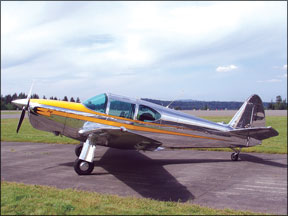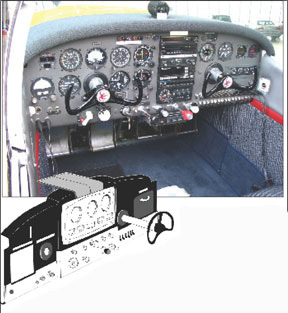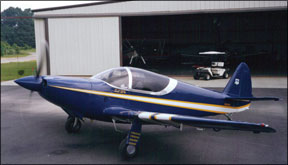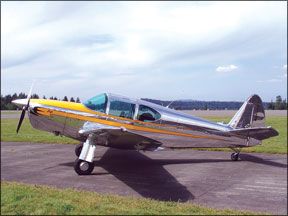Once th

retractable. In some ways, the Swift proves the notion that there’s nothing new under the sun, for its very much the embodiment of the light sport aircraft idea, but executed with a panache the modern iteration of this idea lacks.
For the buyer considering a Swift, the question isn’t so much whether but which. Although there arent many of these airplanes in the fleet about 750 in the U.S. few aircraft have as many STCs and field approvals as the Swift. The newest Swift is almost 60 years old and the typical airplane has seen so many mods that we can easily say that no two Swifts are identical.
Model History
The Swift history is complex and has more twists and turns than a Sean Tucker flight display. Also, major aviation figures pop in and out of the picture faster than a summer thunderstorm in Florida. The story begins oddly enough with a fellow selling serum to Texas cattle ranchers.
In the mid 1920s, a Texan named John Kennedy (no known kin to the political Kennedys) opens Globe Laboratories. The company makes a serum to combat black leg disease in cattle. Kennedy sells every ounce of serum he can produce to Texas ranchers and makes a fortune. He invests his wealth in thoroughbred horses but becomes bored and looks for new challenges during the 1930s.
Meanwhile, another Texan named F. C. Merrill is looking for someone to build his novel, twin-engine “plastic” airplane. The material isn’t plastic as we know it now, but chemically impregnated plywood called Bakelite and marketed under the name of Duraloid. Duraloid is touted as impervious to weather and fungus and is fire resistant. It is also shatterproof and thus an ideal material from which build airplanes.
Next on stage is Frank Bennett, president of a Texas oil firm. Bennett is approached by Merrill and finds the money to build the airplane, but has no place to build it. The airplane is now called the Bennett Bi-Motor or the BTC-1. Bennett enlists engineers and designers from firms such as Martin and Douglas to help with the design. The first BTC-1 is constructed in San Fernando, California and is approved by the CAA in 1937.
Kennedy, still looking for investment opportunities, hears of the BTC-1 and is intrigued enough that he clears out one of his stables to construct the airplane, helping form the Bennett Aircraft Company. Although the BTC-1 does we’ll in military competition, Beech wins a contract for the AT-10 and the Bennett Airplane Company goes bankrupt in 1940. But Kennedy isn’t done with airplanes. He meets R. S. “Pop” Johnson, an amateur airplane builder who has constructed his own home-built knock-off of the Culver Cadet. The knock-off has a slightly more powerful engine and a controllable prop and becomes the basis for the first Globe Swift.
In 1941, the bankrupt Bennett Airplane Corporation is reorganized as the Globe

Aircraft Corporation and the Swift shows up in Janes All the Worlds Aircraft. Globe touts the airplane as capable of carrying two people 600 miles at 130 MPH. Service ceiling is claimed as 16,200 feet.
The original Swift had a main spar made of spruce covered with Duraloid, the same material in the BTC-1. It had fabric-covered ailerons and fuselage. The Swift sported a hydraulically retractable landing gear including the tailwheel. The split flaps were manual. The first engine was a Continental 80-HP four-cylinder swinging an adjustable wooden prop. Fuel capacity was 20 gallons with an empty weight of 816 pounds and a payload of 519 pounds. Maximum weight was given as 1459 pounds, but the thing could land at a pokey 42 MPH.
More Twists
In July 1941, there is a shake-up at Globe. Johnson leaves, but the Swift is a marketing home run. Globe soon has orders valued at more than $1 million and has lined up more than 40 dealers. December 7, 1941, changes everything. Soon, materials are severely restricted and although Globe doesnt build any Swifts during the war, it does subcontract with Beech to build 600 AT-10s, the same airplane that had defeated the BTC-1 in the military competition.
In 1944 Kennedy revisits the Swift and realizes the original design has become somewhat obsolete. Newer airplanes are faster and fly farther. Globe managers are aware that Beech is considering a four-place airplane called the Model 35 and, against the grain, they elect to build an all-metal two-place airplane with conventional landing gear. The landing gear and flaps are now hydraulically operated and the 80-HP engine has been replaced with an 85-HP Continental. An optional upgrade is a 100-HP Lycoming engine.
In January 1945, the prototype CG-1A Swift begins flight test. To facilitate construction, a concession is made in the design. An angular break just aft of the cockpit is used to speed production but it is later realized this break induces a higher drag profile and the Swift is resigned to slower speeds than anticipated.
By the fall of 1945, the Swift is we’ll along in flight test, but flight test pilots learn the Swift will not meet the CAAs requirements for spins. With a six-turn spin and an aft CG with the aileron against the spin, the Swift changes from a normal spin to a flat spin. Rather than certify to the CAA requirements, Swift decides to merely insert a placard prohibiting intentional spins.
In May 1946, the new Swift is awarded its type certificate. Two versions are offered: the GC-1A with an 85-HP engine and the GC-1B with 125HP. Both versions have 28 gallons of fuel the -1A is limited to a maximum weight of 1570 pounds and the -1B to 1710 pounds. Also, the -1A has a fixed pitch wooden or metal propeller while the -1B comes with a high-low pitch propeller. According to the 1947 Janes, the Swift was offered with options for twin floats or ski gear.
To help sell the Swift, Globe hires two WWII fighter aces, Don Gentile and John Godfrey. And to help build all the Swifts the public is ordering, Globe enters into an agreement with the Texas Engineering and Manufacturing Company, TEMCO.
Globe and TEMCO have problems with vendors and with supplies that fail to arrive on schedule. Also, a major error has been made in accounting. It takes more time and more money to build each Swift than anticipated and as a result, every aircraft is sold at a loss. Creditors and banks close in and by 1947, Globe is in financial trouble. In what would today be considered a hostile takeover, a group of eastern financiers tries to remove Kennedy from the company helm. But the company is closed down instead.
TEMCO had built 329 Swifts but had been paid for only 223 of them. Some 210 Swifts were in various stages of completion and some, already completed but without buyers, were sitting in the hot Texas sun. By extraordinary efforts, TEMCO was able to pull out of the financial dive by December 1947 and revive the company. It continued production until the last Swift rolled off the assembly line on August 23, 1951.
By the end, Globe had built 408 GC-1As. During the partnership with TEMCO, a total of 833 GC-1Bs were built in only six months. After Globe went belly-up, TEMCO went on to produce an additional 260 GC-1Bs. According to one source, the total number of Swifts varies from almost 1500 to 1521 airplanes.
While TEMCO was building the Swift, the company received an inquiry from the Philippine government. They wanted a military version of the GC-1B. TEMCO modified a Swift to become the TE-1A in 1948. It had had tandem seating, a new canopy and a rudder with a big square tip and the engine was upgraded to 145 HP. Shortly afterwards the U.S. Air Force began looking for a new trainer. Three companies entered the competition: Fairchild with its XNQ-1, TEMCO with the TE-1A and Beech with its Model 45. Beech won hands down with what became the T-34. But TEMCO wasnt ready to give up on the TE-1 so they upgraded the airplane with a Franklin 165-HP engine. Shortly afterwards, several countries looked at the TE-1 which, by 1953, sported two .30 caliber machine guns mounted in the wings and hard points for 10 2.75-inch rockets.
The TE-1A became the T-35 Buckaroo. The Royal Saudi Air Force had eight pilots trained in Britain but no airplanes. The RSAF ordered 10 T-35s plus spares. Eventually, TEMCO would make more money providing spares than they did on the initial order for 10 airplanes. The RSAF used the Buckaroos into the early 1960s. One restored Buckaroo rests at the Swift Museum in Athens, Tennessee.
The first and last Swifts are still flying, but in the intervening years, many have been written off and its said that only a small number havent been on their belly at least once. The Swift Association lists more than 750 Swifts in the U.S. that are either airworthy, under restoration or considered restorable.
Flying the Swift
John Davis, retired airline pilot and certified Swift instructor, has more than 3000 hours in taildraggers and more than 1000 hours in Swifts. Davis emphatically says, “The Swift is not just another tailwheel airplane. This is a high-performance, retractable gear airplane whereas many other tailwheel airplanes are fixed gear with fixed pitch propellers. And they are not considered high performance.”

Davis stresses a few points about flying the Swift and the first is that three-point landings are not the routine. “When you get the Swift slow, the airplane is in a fairly high drag configuration with gear and flaps fully extended. It doesnt take much for the airplane to slow quickly and if you are still two or three feet in the air when the sink rate develops, you can drop the airplane in for a hard landing or worse,” Davis says.
He recommends that Swift pilots make wheel landings until they get experienced with the Swift. Davis said he does about two thirds of his landings with full flaps and in a three-point attitude, but he notes that a real three-point is done at or near the stall and there is little room for error. Davis says, “The Swift is not an airplane that is trying to kill you, but it does require skills and respect. And you cant quit flying it until you are in the chocks and shut down.”
Davis notes that Swifts don’t like strong crosswinds from the left. “If you have the choice, choose a right crosswind. Also another problem new Swift pilots have is getting the tail up too early. You can lift the tail early and you have very little rudder control. Leave the tail on the ground and then come right on up with the tail to the takeoff attitude. If you don’t do it right, you can wind up blocking out the rudder and without sufficient control,” he says.
Jim Montague is one resident authority on the Swift and on the Swift website (www.globetemcoswift.com) says, “It is not correct to say Ive flown tailwheels, I can fly a Swift.” Davis and Montague recommend that pilots with no tailwheel experience get some hours in a Citabria or a Cub before hopping in a Swift.
Maintenance, Parts
Jim Thomason specializes in maintaining Swifts. Thomason has his hangar on a grass strip near Greenville, South Carolina and has worked on a lot of Swifts. He says the Swift is one of the most modified airplanes flying. The paperwork becomes a real issue for someone buying a Swift. Some airplanes have 337s. Some have STCs, but almost always, there’s some paperwork issue where the airplane and paperwork don’t line up.
“The problem,” Thomason says, “can be something like a part is approved for a given engine, but there is no approval for it to be on a Swift. When considering a Swift, it is imperative that the buyer ensure the paperwork is good.”
The next real issue is corrosion. The airplane is now close to 60 years old and corrosion is a major consideration. Mechanics find corrosion in the vertical fin. the tailwheel area and around the horizontal stabilizer. Various people offer reasons for why this happens, but the big thing is that it does happen. Look for corrosion caused by rodents getting in the airplane and leaving droppings, Thomason says.
A second inspection is for exfoliation. Thomason has seen airplanes with metal that “…broke up like a cracker. I have found it on wing skins, which is not that difficult to remove and replace, but the Achilles heel is when you find it on the spar cap extrusions. It could come from improper heat treatment. At any rate, if it is on the wing spar, it is no longer airworthy and you have to replace it.”
The problem with spare parts is that few, if any, are being made. “Each part you have to replace has to come from another Swift, which can mean there is one more Swift that is no longer flying. The Swift Association makes some spare parts, but sometimes if you need the part, it may not be available and you will have to either have it made or replace it and get a field approval. Thomason refutes the idea that a Swift can require more maintenance than other airplanes with retractable gear and constant speed props.
Currently there are more than 18 ADs on the GC-1A and 19 ADs on the -1B. Instructions on how to find the website and the specific Swift (-1A or -1B) can be found on the Swift home page, www.globetemcoswift.com. Montague notes that since the last AD was issued in 1964, there should be no problem with compliance, but make sure the paperwork is accounted for.
Performance
don’t expect to find any handbooks on performance. With all the various engine-propeller combinations, the buyer has to fly the airplane to figure out what it can and can not do. And one problem will be the legal weight and balance.
Over the years, the Swifts have added more than a few pounds. Montague says he has seen very few Swifts with an empty gross weight of 1200 pounds and many are around 1300 pounds. Some chubby Swifts with the big engines gross at more than 1500 pounds empty, which can cause a problem if they don’t have the STC for increased weights. The standard maximum is 1710 pounds, with an STC to increase weights to 1835 pounds for airplanes with engines up to 180 HP and 180 HP and above can be approved up to 1970 pounds. The problem becomes obvious.
The standard Swift has 26 gallons or 156 pounds of fuel in the main tanks. With a 170-pound pilot and a 150-pound passenger, that adds up to 476 pounds. That means the Swift has to weigh less than 1100 pounds for a legal weight; not likely. The choice becomes obvious, less fuel or lighter passengers. Or you can have the Swift checked for unwanted pounds.
Thomason says he has seen few Swifts lighter than 1200 pounds, but adds that he has taken as much as 125 pounds off one Swift when it came in for maintenance. He found wiring harnesses left over from various additions and Cessna 150 seats, a common modification. “It also had every kind of insulation including household and automotive and three layers of paint,” he said.
MARKET SCAN
There’s no set figure for a Swift since there is no standard configuration. For example, on the Swift Website, there are a number for sale ranging from $38,900 for a Swift with a 145-HP engine, a 9-gallon aux tank, Cessna 150 seats and Cleveland brakes, to a mid-range Swift posted at $75,000 with updated avionics, increased gross weight kit, closed wing slots and recent annual.
At the upper range is a Swift with new leather interior, bubble canopy with every legal mod possible, re-skinned and flush riveted. The airplane also had thoroughly modern avionics with an NSD360 HSI, Century autopilot and Garmin GNS430 navigator. Asking price: $125,000.
Owner Feedback
In the 18 months I have owned a 180-HP Swift, it has been an adventure. In the early months of flying N78311 out of 47A north of Atlanta, I made more go-arounds in the first year than I had done in all the previous years of flying in the military, general aviation, Part 135 and the airlines. 47A is noted for its crosswinds as I was informed after I had bought 311 and everyone in the Atlanta area goes to 47A to practice crosswind landings.
With an HIO-360 (field approval) pulling the Swift around, I can expect about 3 hours flying before I land. I have 26 gallons in the wings and an aux tank holding 9 gallons. Leaned out I burn about 9-10 gallons an hour. I routinely plan for a true airspeed of 135kts.
The Swift is a conversation piece. Many can not believe the airplane is 60 years old (mine is a 1946 GC-1B). Once when I landed in Oklahoma the tower asked when I was planning on departing. When I asked why they wanted to know that, the tower chief said they were closing the tower “…in about 30 minutes and we have never seen one of those things up close. Would you mind waiting a few minutes so we can see it?” I gladly obliged.
In the past few months I ran across the Latin term
ancora imparo which roughly translates into “Im still learning.” For the pilot who wants a Swift or who is flying a Swift, it is a good motto to adopt because the Swift is always ready to teach you a new lesson.John Wiley
Atlanta, Georgia
When I bought my Swift in 1972, I was checked out by its previous owner, a CFI. He taught me not to flirt with the stall. Also, on takeoff, never pull the Swift off prematurely, but let the airplane fly when proper airspeed is reached. His final approach speed was 85 MPH and touchdown was 75 MPH. I listened and complied.
I talked to many other Swift pilots about the stall characteristics and their universal reluctance to explore this part of the flight envelope. I started to think about what could be done. I gathered data and submitted several preliminary applications to the ABQ FSDO and finally had an application accepted that met their standards in 1987. A single aircraft STC number SA7643SW for N78083 was granted in 1989. This replaces the stall strips on my 180-HP Swift with a max gross weight of 1970 pounds.
The slow speed and stall characteristics are radically changed. The stall speeds now are 48 MPH flaps down and 56 MPH flaps up. Three-point landings are made at 45 MPH indicated. Tailwheel-first landings can be routinely made. A final approach speed of 65 MPH is perfect.
Last year, I sold this STC to Don Bartholomew who is currently replicating the required tests with the goal of obtaining a multiple-aircraft STC which includes 125-,150-, 180- and 210-HP engine installations. He is making good progress. His e-mail is: [email protected]
Lew Chesley
Via e-mail
As a long time reader, I am glad to see the Swift get some attention. I have had four Swifts, the first purchased in the early 1980s for $8700. My current Swift is worth about $125,000. Today, you can find prices on Swifts from about $40,000, to around $150,000, depending if it is a stock model with 125-HP or one of the super customized models with 210-HP. All Swifts fly great; with light control forces it is good for light aerobatics or just having fun. I put Swifts and Corvettes in the same class. They are not the most practical things, but sure are fun to have.
I am just an average pilot and have had no trouble in takeoffs or landings in wind. I have landed in wind that would have scared me if I knew it was that strong, but the airplane handled it well.
The Swift would be a good trainer for anyone about to get checked out in a real P-51 Mustang. The takeoff and landing characteristics are much the same. I once splurged and bought an hour in the P-51 Crazy Horse and it was so much like the Swift I was right at home.
The retractable landing gear is mostly trouble free if you simply maintain it like any other retractable. It is electric/hydraulic, so if you lose electric power, it has to be hand cranked down. I have done that once when a generator quit and I ran the battery down before I caught it.
The Continental O-300 145-HP engine is a common one for the Swift. The earlier ones had a pull type starter engagement. The O-300D is more desirable because of its normal key-start capability, its alternator instead of a generator and a vacuum pump. You will find all of the small Lycomings up to 200-HP in Swifts, but the most popular big engine is the Continental IO-360 of 210-HP. A pure stock 85-HP Swift is rare-you can never have too much horsepower.
Some popular mods for Swifts are removing the control wheels and putting in sticks, removing the entire top of the cabin and replacing it with a bubble canopy, closing the slots in the wings, adding fuel capacity for the big engines, gross weight increase, full IFR panels. In short, they can be highly modified.
I am an A&P so I usually do most of the actual work on my airplane and get an inspector to check everything and do the paperwork part. Annuals usually cost me $500 per year.
Part of owning a Swift is ego; it feels good when you stop somewhere for gas and the crowd comes out of the FBO to look, especially when the quarter-million dollar spam can beside you is being ignored.
There is an electronic newsletter for the Swift put out by Denis Arbeau at [email protected]. The Swift organization has its own parts department and museum in Athens, Tennessee. The Swift Website is http://www.globetemcoswift.com/.
Marvin Homsley
Via e-mail





